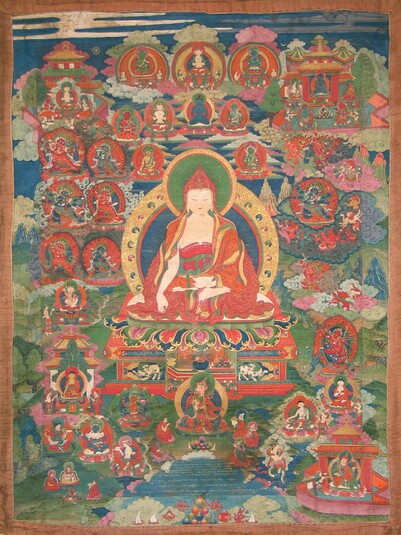
Item: Padmasambhava
| Origin Location | Tibet |
|---|---|
| Date Range | 1700 - 1799 |
| Lineages | Nyingma and Buddhist |
| Material | Ground Mineral Pigment on Cotton |
| Collection | Rubin Museum of Art |
Classification: Deity
Padmasambhava with Yang Ter Meditational Deities and Narrative Vignettes. The painting was created in 1732 by the artist Lhundrub Rigdzin and with the help of Palden Chogyong, the son of the famous Terton Dechen Lingpa (1663-1713), it was blessed by the 8th Shamar, Palchen Chokyi (1695-1732), and Tai Situ Chokyi Jungne (1700-1774) while the 12th Gyalwa Karmapa, Jangchub Dorje (1703-1732) and Shamar Rinpoche were travelling to China. Both the Karmapa and Shamar passed away of illness in China in this same year.
The painting is important because of the amount of information provided in the inscriptions along with the names of the historical figures and name of the artist.
རྗེ་རིན་པོ་ཆེ། ཀརྨ་པ་རྒྱལ་བ་ཡབ་སྲས། ས་སོ་དགོན་ནས། འཇོང་ཡུལ་ཕེབས་ཞོར། གོ་འཇོ་ལྗོང་བསམ་གྲུབ་ལྷ་རྩེ། སྐྱེད་མོས་ཚལ་ནིའུ་ཟིང་ཆུ་འབབ་ལྡན། སྨར་ཆུའི་འགྲམ་སྐུ་འཆག་ཕེབས་སྐབས། ས་སྟག་བོད་ཟླ་༩་ཚེས་༡༠་ཉི་མ་རྩེ་ཤར་དུས། རྗེ་རིན་པོ་ཆེ་ཀརྨ་ཞྭ་དམར་པ། སུ་ཏུ་རིན་པོ་ཆེ་རྣམ་གཉིས་ཀྱིས་ཞལ་ཐང་འདི་ལ་ཕྱག་མཛུབ་རྗེས་གོང་འོག་ཏུ་བཏབ་ནས་རྟེན་མཆོག་ཏུ། དམིགས་རིམ་རབ་གནས་བརྟན་བཞུགས།བཀྲ་ཤིས་བསྔོ་སྨོན་རྒྱས་བཏབ་པར་བརྟེན། ལྷ་བཟོ་ལྷུན་གྲུབ་ རིག་འཛིན་གྱིས་བསྐུལ་བས། གཏེར་སྟོན་བདེ་ཆེན་གླིང་པའི་སྲས་ཆོས་སྐྱོང་དཔལ་ལྡན་གྱིས་ཞུས་རོགས་བྱས་པའོ།
"Precious Master! Karmapa and sons, while proceeding for Jang [China], they stopped at Gojo Samdrub Tse (Gojo sam drup tse) and nearby the park of Marchu (smar chu) for a walk. At the early sun rise of the Earth Tiger year [1732], on the 10th day of the 9th month, Master Shamar and Situ both put their finger print on this object of worship respectively for the practice of visualization and further blessed with the reciting of some prayers."
Due to the constant request from the artist Lhundrub Rigdzin (lhun drup rig zin), [after requesting] Palden Chogyong (pal den chos kyong) - the son of Dechen Lingpa (dechen ling pa) - to help him to ask for the blessings."
There are inscriptions on the front of the painting for most of the figures. There is a long inscription at the bottom front of the composition which also states the artists name. The reverse of the painting has a large black stupa dominating the space. At the top of the back is a lengthy inscription with the details of the blessing of the painting by Shamar and Situ. At the bottom of the painting there is another inscription which relates to the narrative of Trisong Detsen.
Jeff Watt & Karma Gellek 8-2013
Padmasambhava: Painting Masterworks (RMA)
Subject: Inscriptions Main Page (Painting)
Collection of RMA: Historically Important Works
Padmasambhava Main Page
Collection of Rubin Museum of Art (RMA): Main Page
Padmasambhava: 'Revealed Treasure'
Subject: Dating of Art on Himalayan Art Resources
Subject: Inscriptions (Historical Information)










